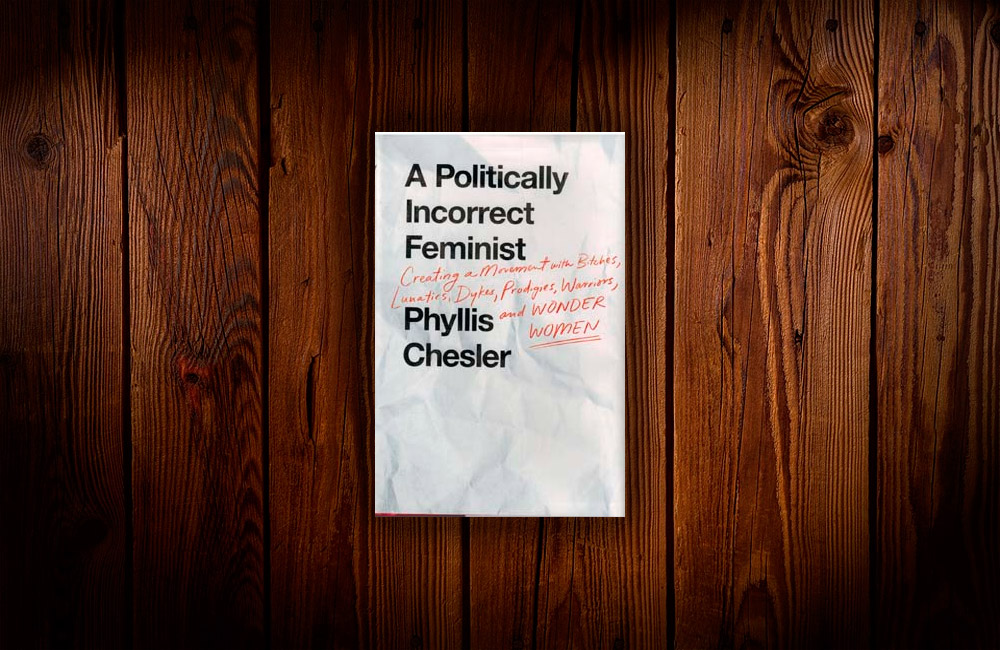Possibly before, but especially after publication of Women and Madness, which exposed the practice of falsely committing women to insane asylums and the abuse of women within those institutions, author Phyllis Chesler has been among America’s best-known feminists. Helping to organize the feminist movement in this country was not without its challenges, as is attested by the subtitle of this memoir: “Creating a Movement with Bitches, Lunatics, Dykes, Prodigies, Warriors and Wonder Women.”
Readers gain personal insights into almost all the celebrities within the feminist movement, including Bella Abzug, Betty Friedan, Gloria Steinem, Andrea Dworkin, Letty Cottin Pogrebrin, and Kate Millet, just to name a few, and learn that like many an activist or political movement, feminism in America has its internal controversies and personality clashes, as well as its moments of solidarity.
In one searing chapter, Chesler writes of being raped by the late United Nations Undersecretary Davidson Nicol, under whose auspices she had helped to arrange an international feminist conference in Oslo When she told some high-ranking friends in the feminist movement the harrowing details of her rape, instead of coming to her aid, they took the side of Nicol, who was from Sierra Leone. How could they do this? As Chesler understood it, her exploitation was less important to these friends than the perceived greater good of the movement. Nicol, an African, was a powerful man, and accusing him might be made out to be racist.
While such schisms in the feminist world make for important and at times riveting reading, I should like to focus in this review on some of the feminist issues that impact upon the Jewish community, of which Chesler is an activist part.
When Chesler’s son Ariel was born, a feminist brit milah was conducted with such luminaries as Steinem, Erica Jong, and Aviva Cantor Zuckoff in attendance. He received such blessings from these women and their souers as “May you never know any more pain than you’ve known today, on the day of your circumcision”; “May you be strong enough to be the son of a feminist”; “May your mother be your friend all your shared life”; “May you honor the women in your life as we honor you.”
Another feminist ceremonial was a woman’s Passover seder, many of which, to Chesler’s dismay, have tended to elevate Moses’ sister, Miriam, to the role of principal protagonist. “It is understandable but childlike, this hunger to see our own gendered human image writ large,” Chesler wrote. She recalled at one seder that the women attendees introduced themselves according to their matrilineal descent. “I am Phyllis, daughter of Lillian.” “I am Letty, daughter of Ceil.” Chesler observed: “We were a band of (motherless) sisters in search of our female ancestors. We created a ritual of verbal matrilineage, and introducing ourselves this way was—and remains—psychologically empowering.”
At subsequent seders, the idea of a large diaphanous sash to “literally bound us physically” was introduced, which Chesler, flashing her humor and wit, called “the sacred schmatta.” Binding all the women together fostered a sense of elevation, but after a while, Chesler grew tired of the idea, calling it a “form of idol worship.”
Chesler memorialized Rivka Haut, an Orthodox woman with whom she studied Torah once and sometimes twice a day for nearly 25 years. Haut was the kind of woman that perhaps Chesler’s mother had wanted Chesler to be. “Although Rivka remained rooted within the Orthodox tradition, she still did radical things. She pioneered prayer groups for women, which at the time, most Orthodox rabbis vehemently opposed –so much so that one of her daughters nearly lost her future husband because his father feared that Rivka’s radicalism might ruin his son’s life and those of his future grandchildren.”
Haut also was a strong advocate for the agunot, the women in loveless marriages whose husbands refused to give them a religious divorce. “Rivka considered these women martyrs to the faith because they refused to leave Orthodox Judaism even though their rabbis continued to condemn them to lonely, outcast lives.
In Israel, Chesler became a leader in the campaign among women to pray freely at the Kotel, without the restrictions of place and mode of prayer placed upon them by the Orthodox establishments. Describing the moment when the nascent Women of the Wall movement first carried the Torah to the Kotel, and donned tallisim and kippot, Chesler commented: “Without knowing it, this is what I had longed for all through my Orthodox childhood in Borough Park, Brooklyn. This was a tikkun, a redemptive repair for my not being allowed to become a bat mitzvah (Orthodox), and for relegating me to lesser (intellectual) life in terms of Torah study. This moment was a dream come true—one I never knew I’d been harboring all those years.”
There is much information to absorb in this volume, and students of the feminist movement will want to read Chesler’s memoir over and over again.
I personally wished that Chesler had written in depth about another issue, the persistent anti-Semitism, often disguised as anti-Zionism, on the political left, and the hypocritical demand by some radical feminists that no matter how egregiously some Islamic societies treat women – with honor killings, forced veiling, requirements that women not appear in public without a male escort, and the like – that Israel, notwithstanding its tradition of empowering women (remember Golda Meir?), be forever cast as the oppressor, the colonialist, and violator of human rights on the theory that “progressive groups” must support each other’s causes at all costs.
Chesler has written or co-edited 17 other books in the feminist canon. Perhaps a book addressing this issue would make a wonderful 18th – a chai offering?
Republished from San Diego Jewish World


























